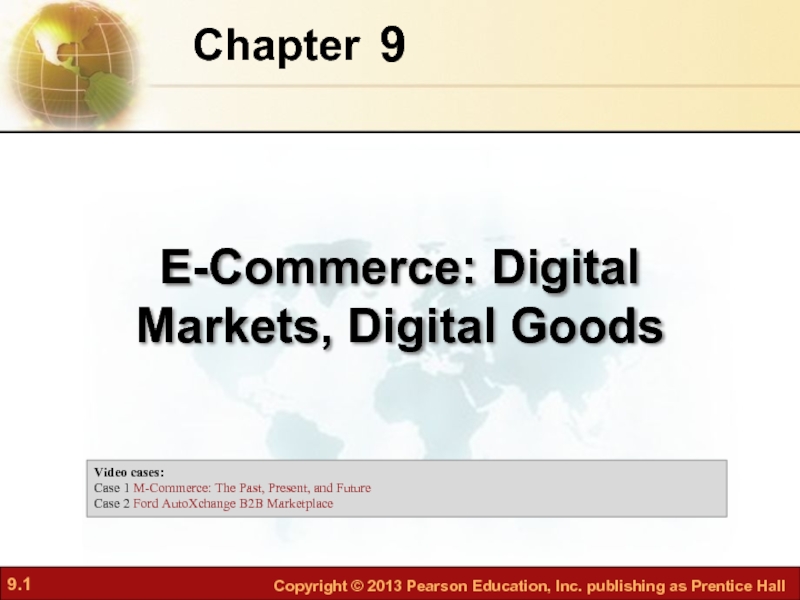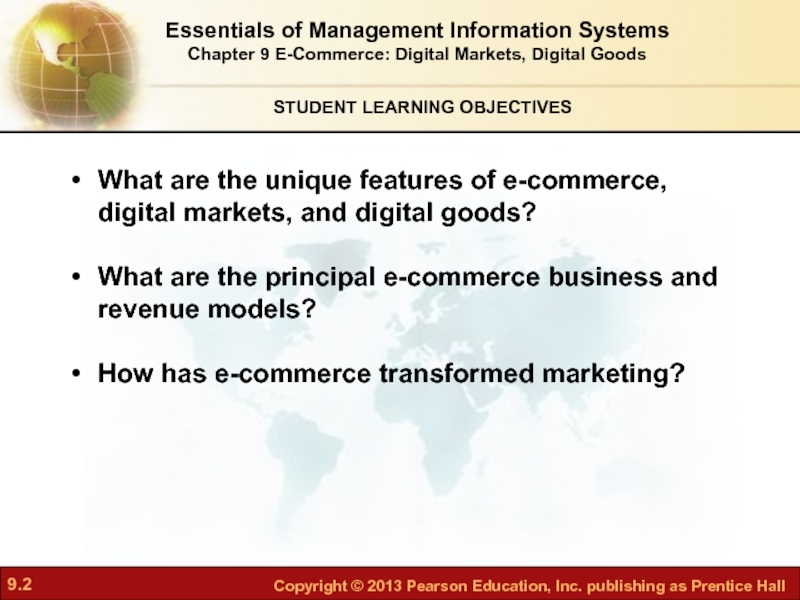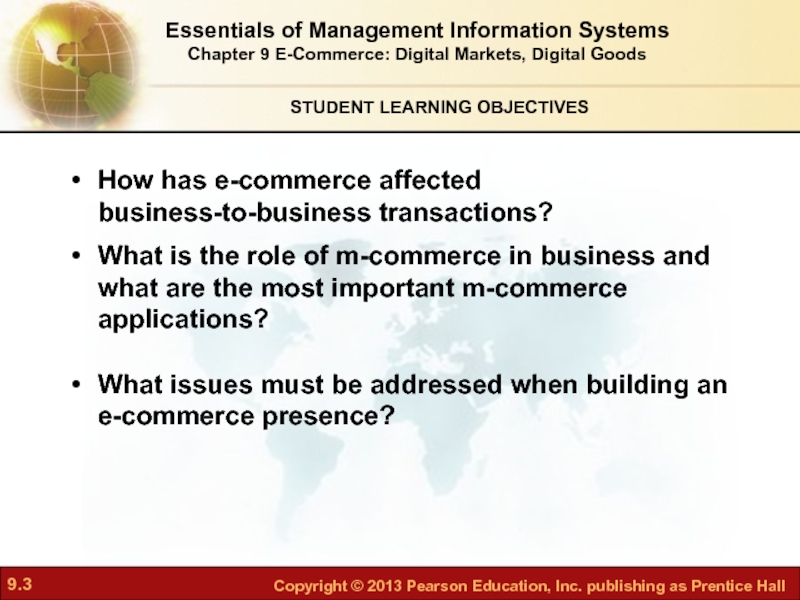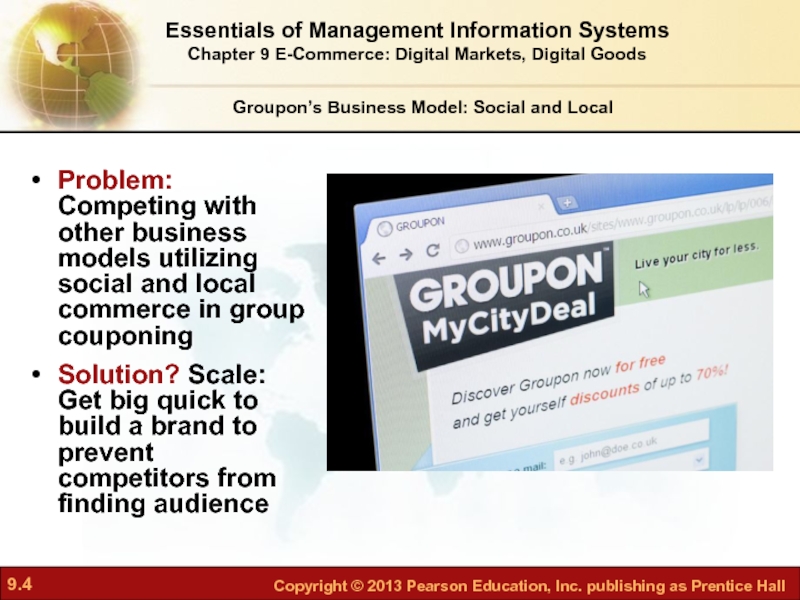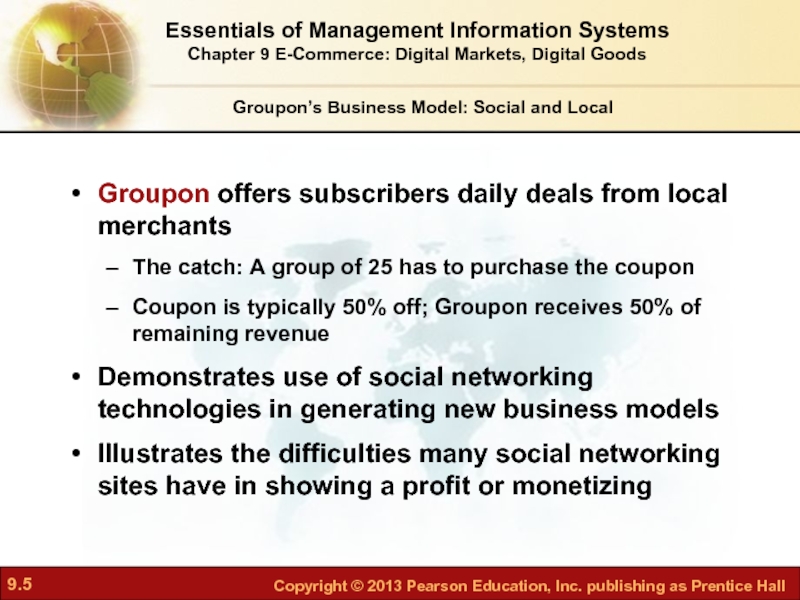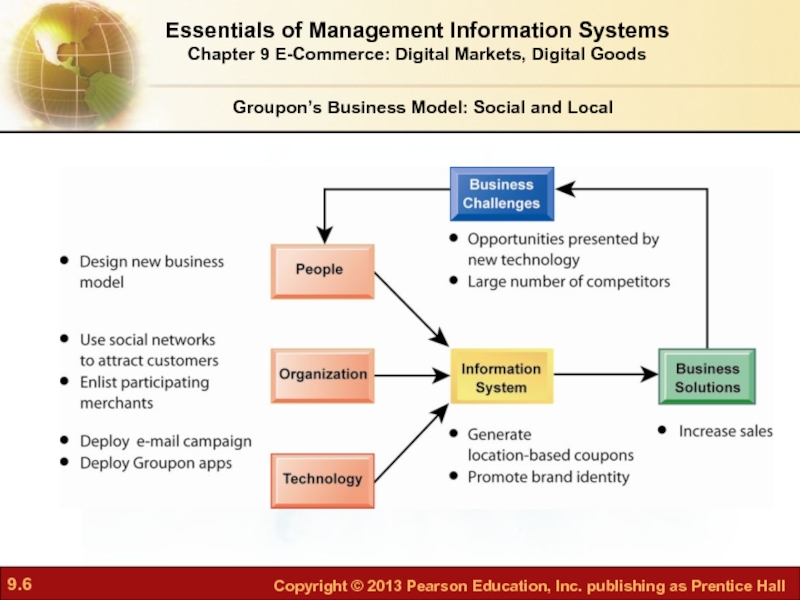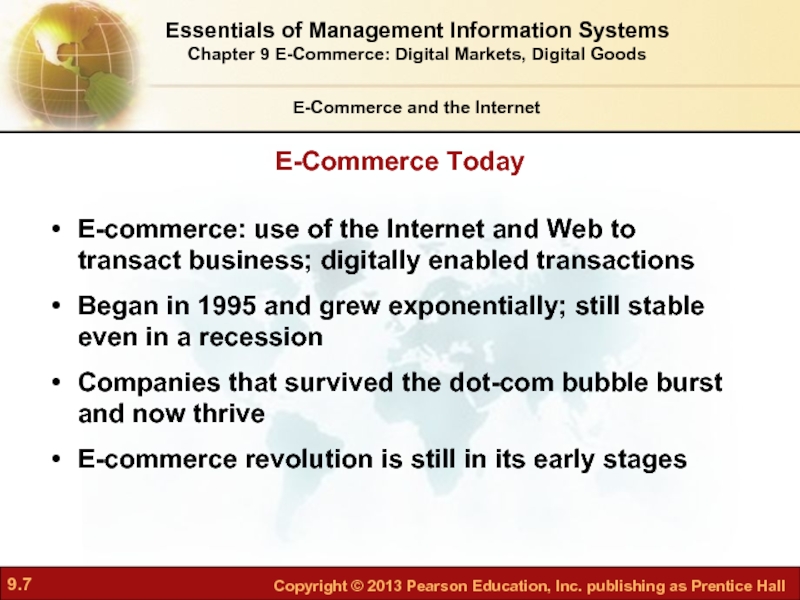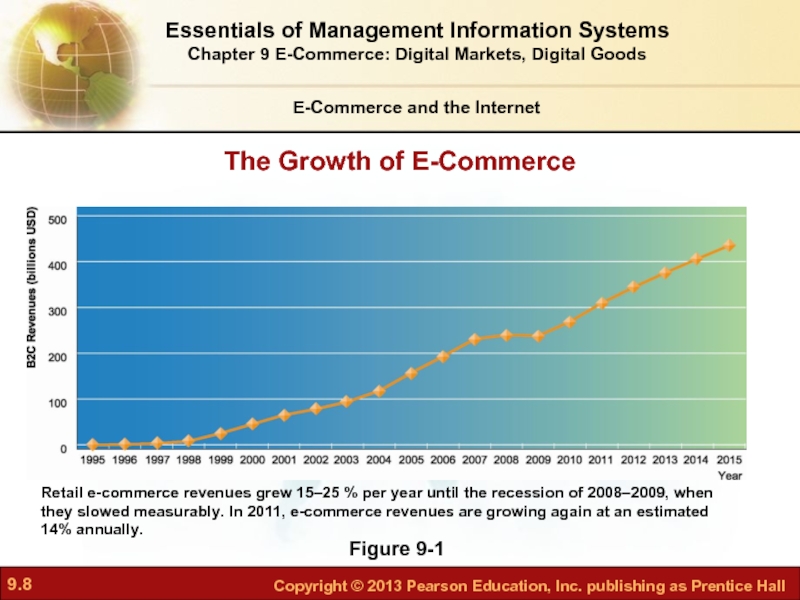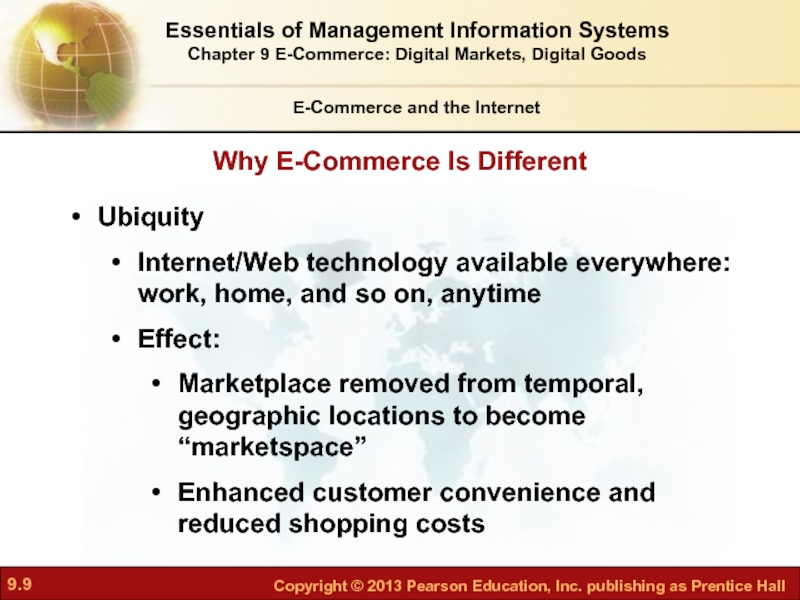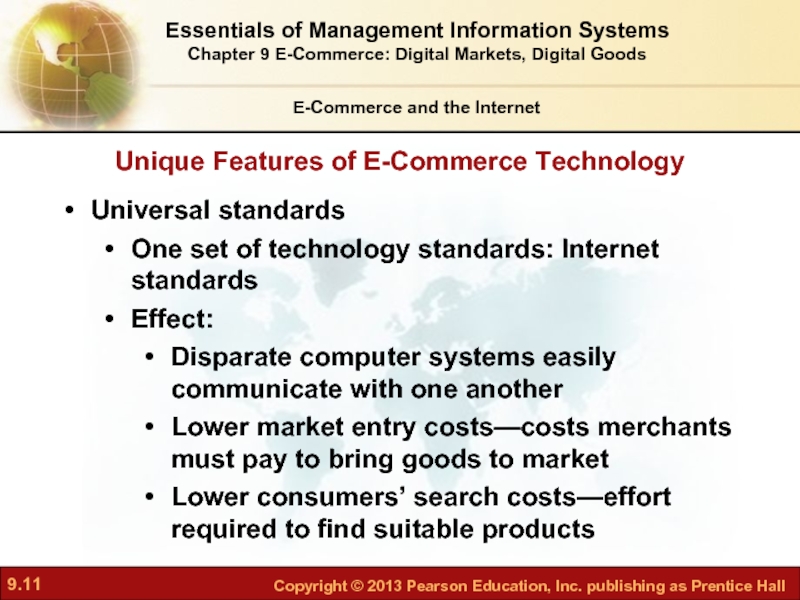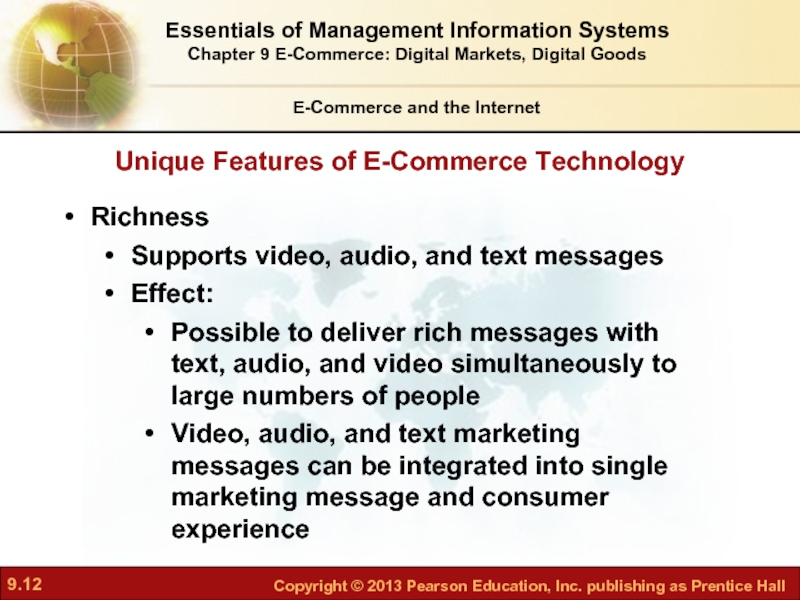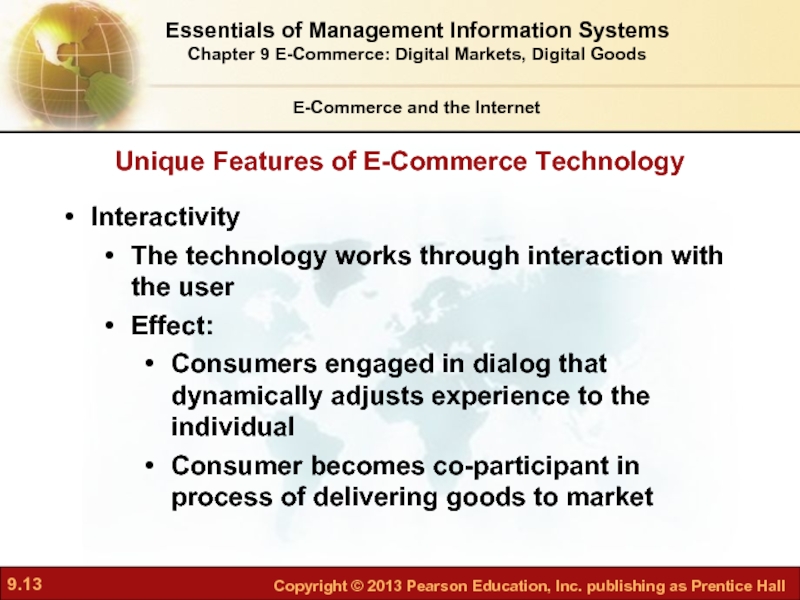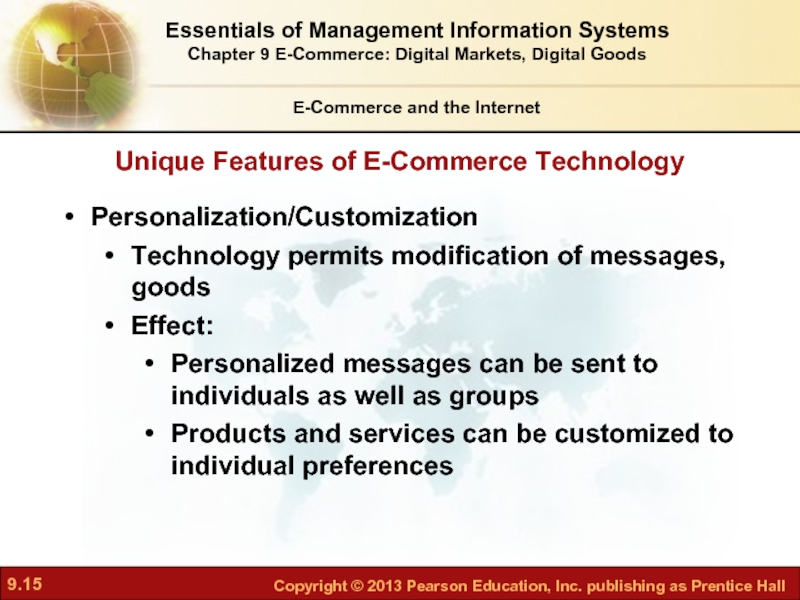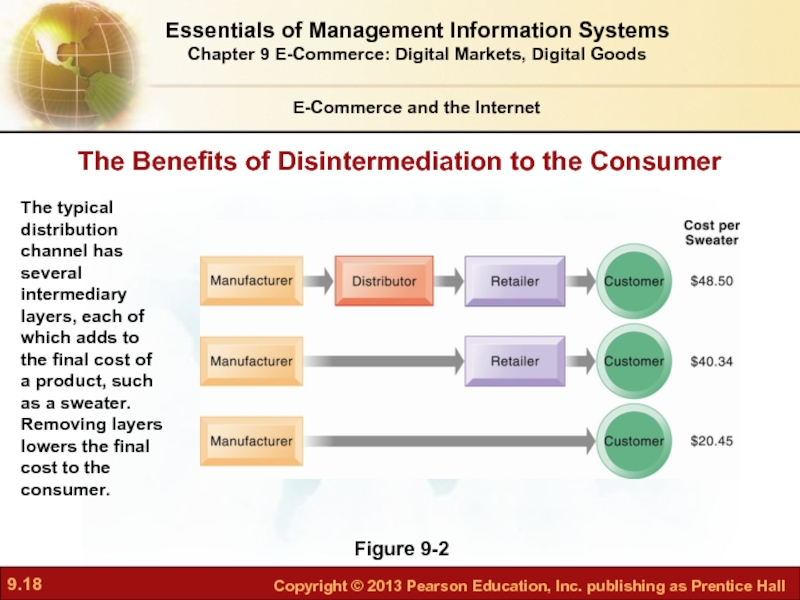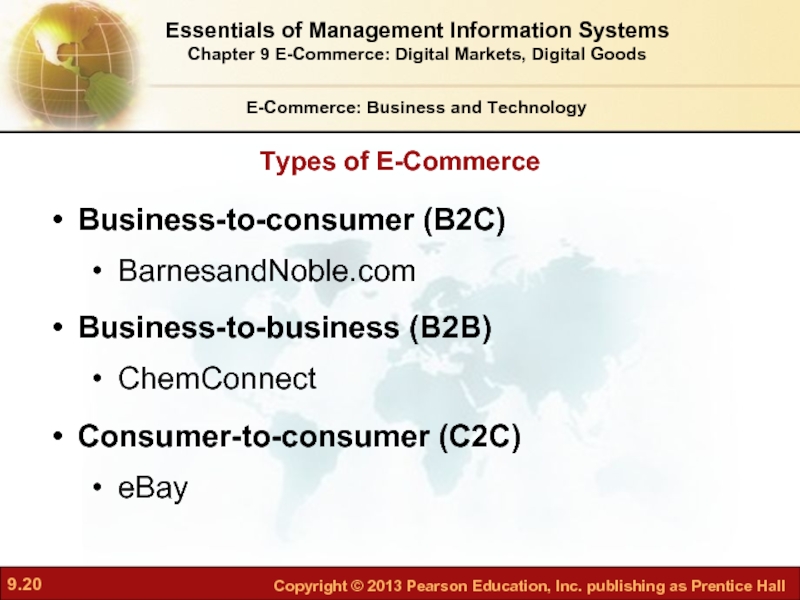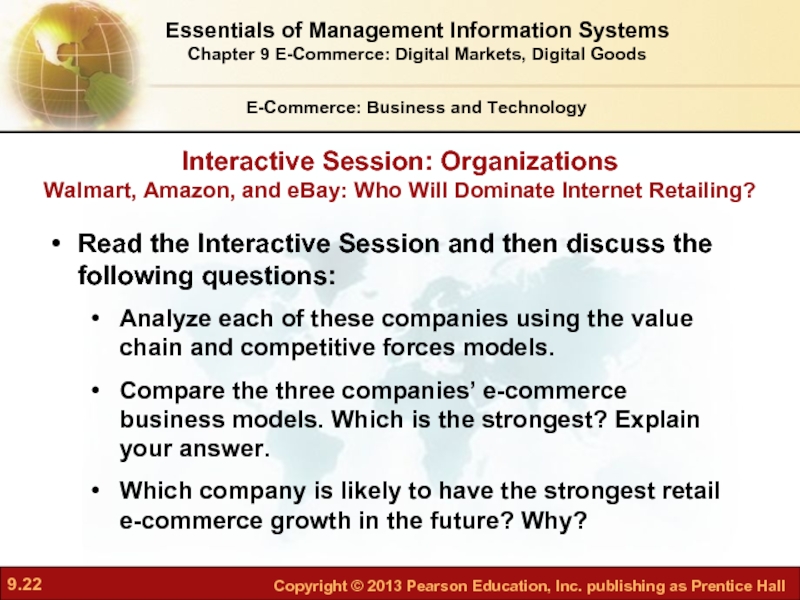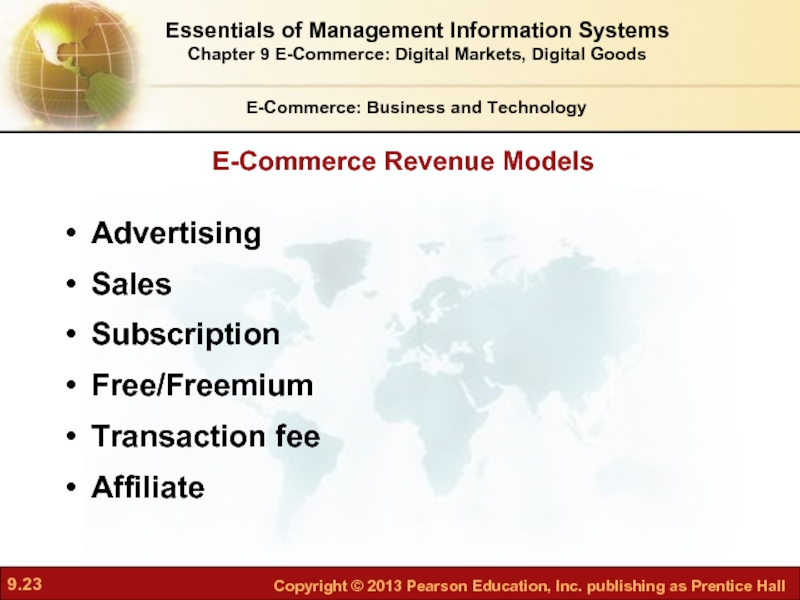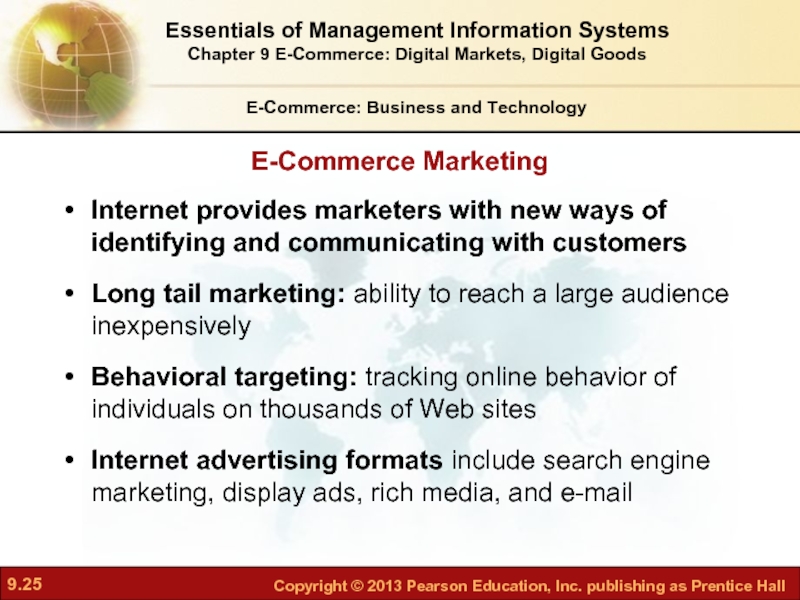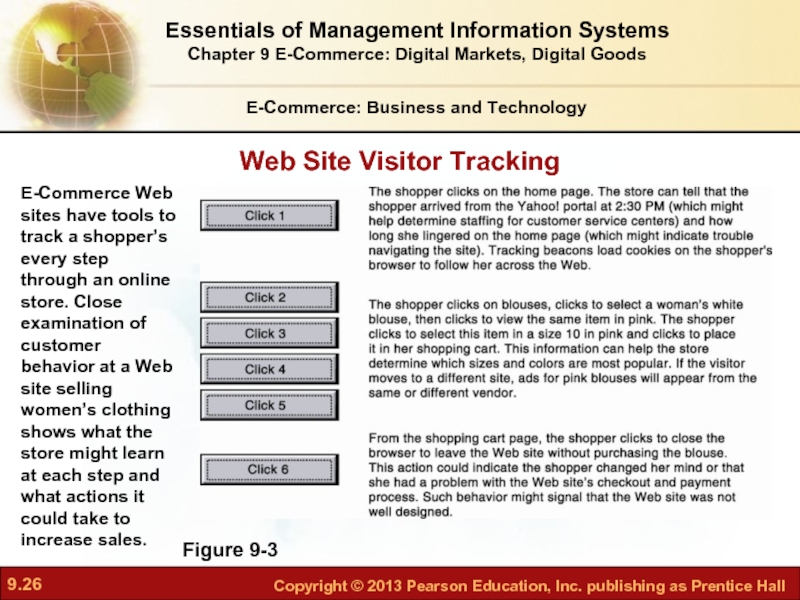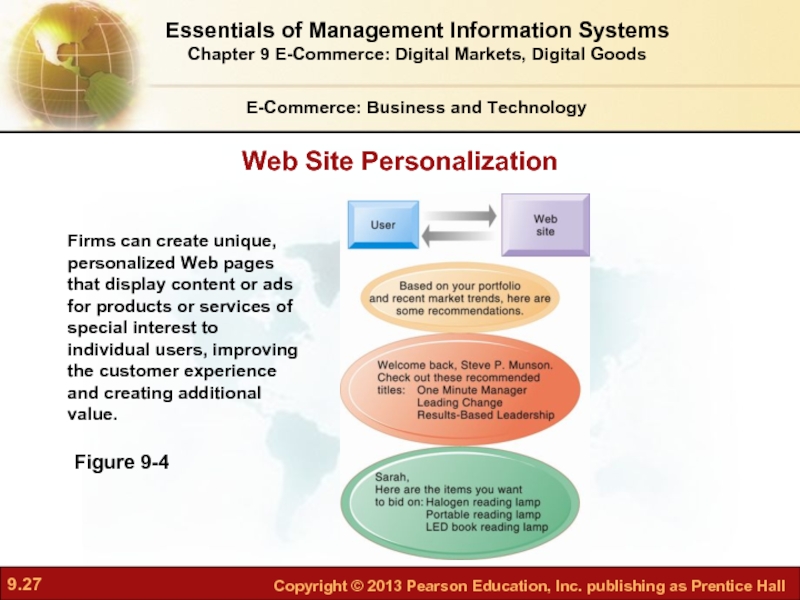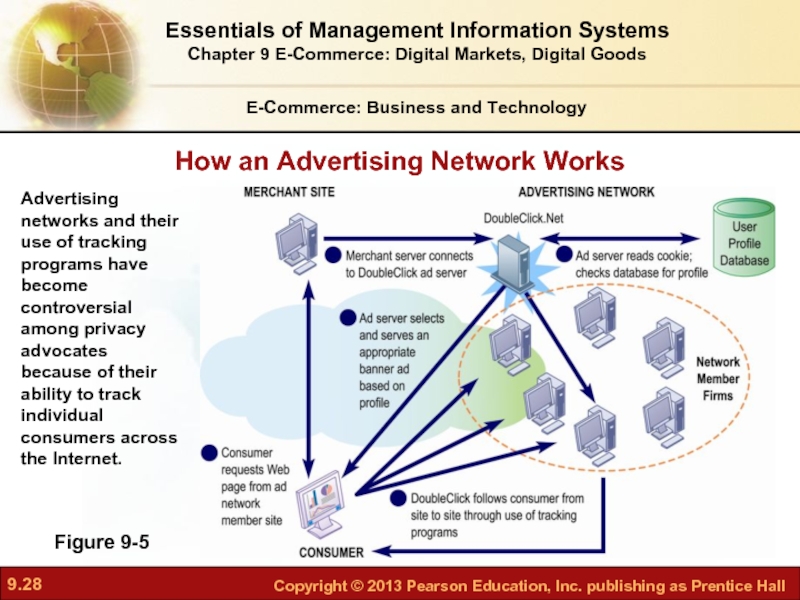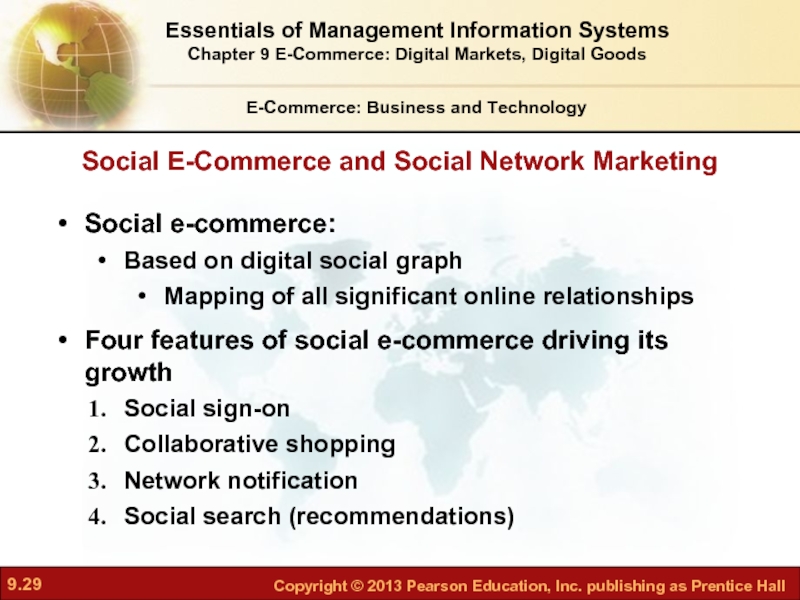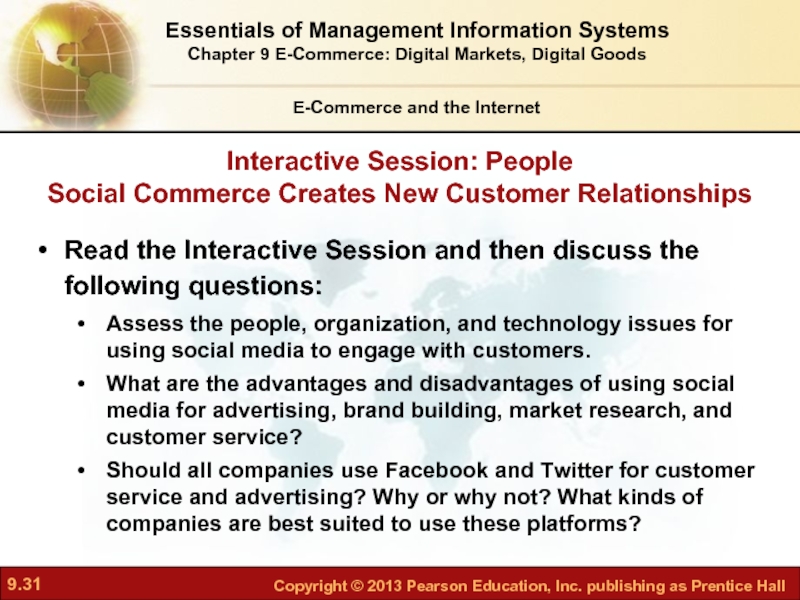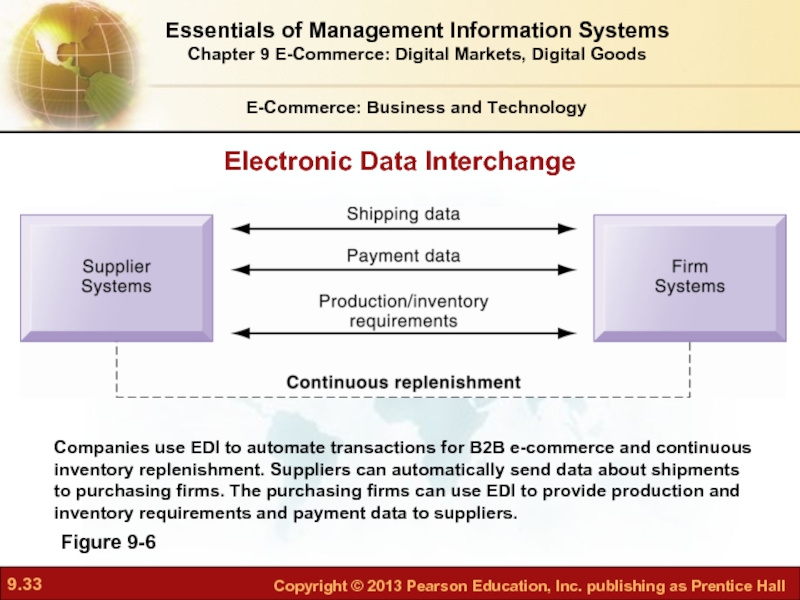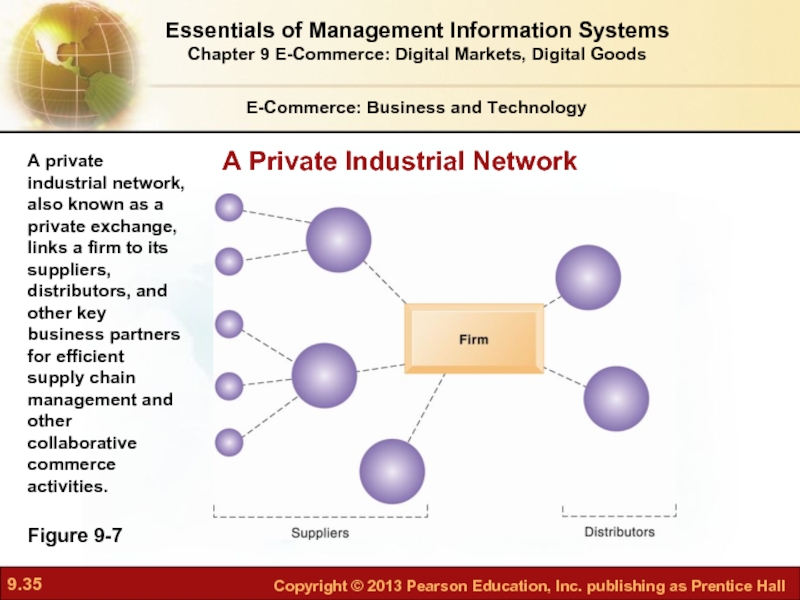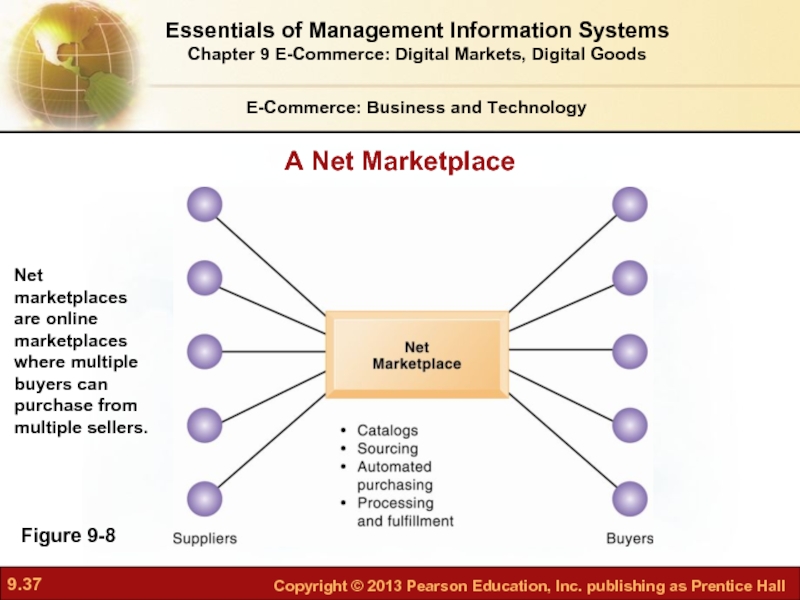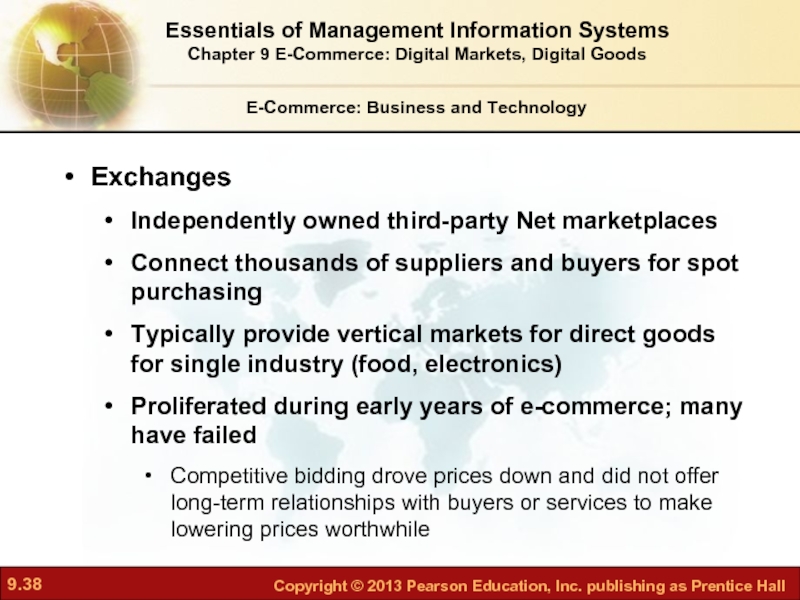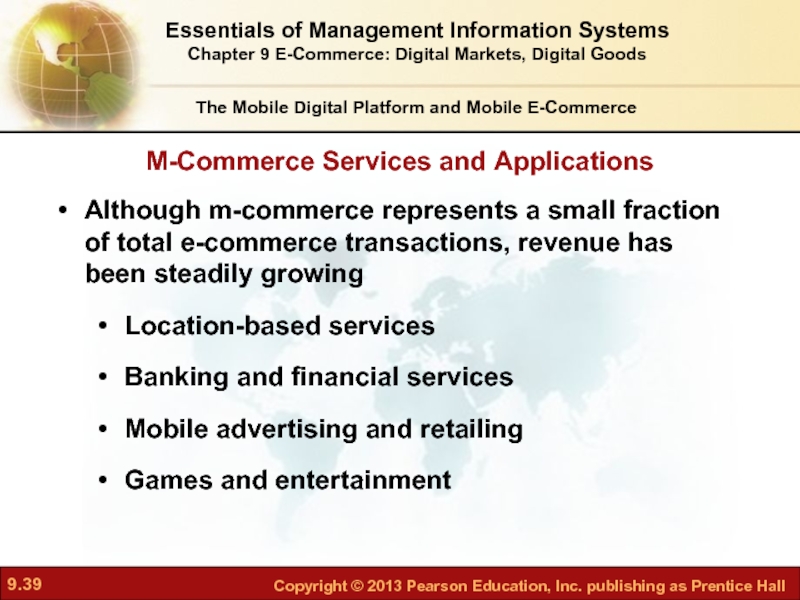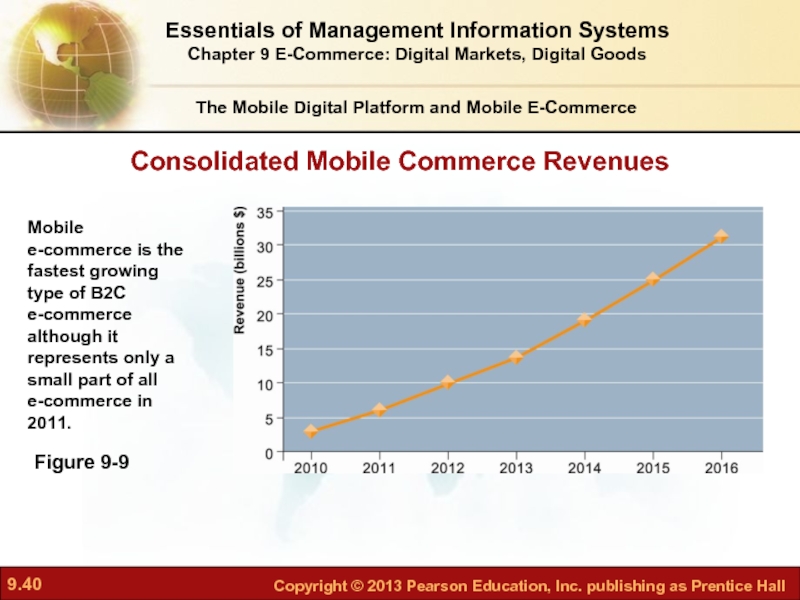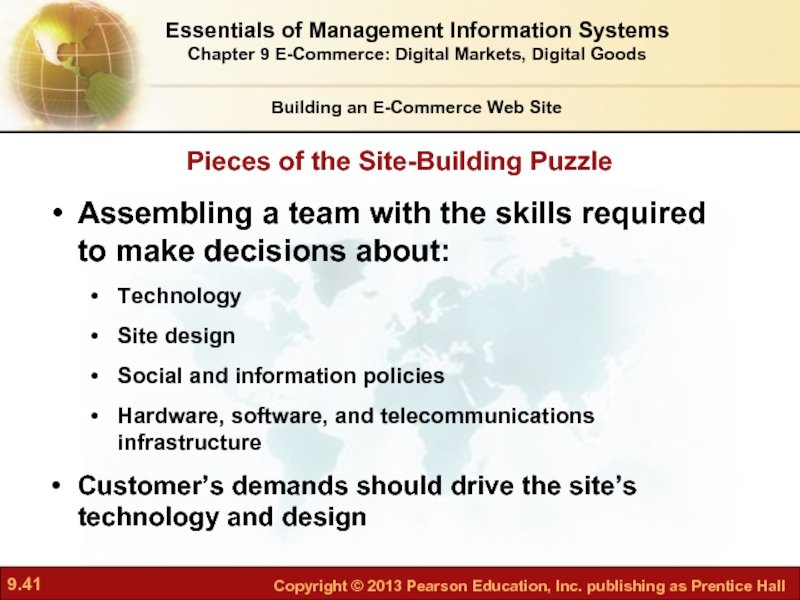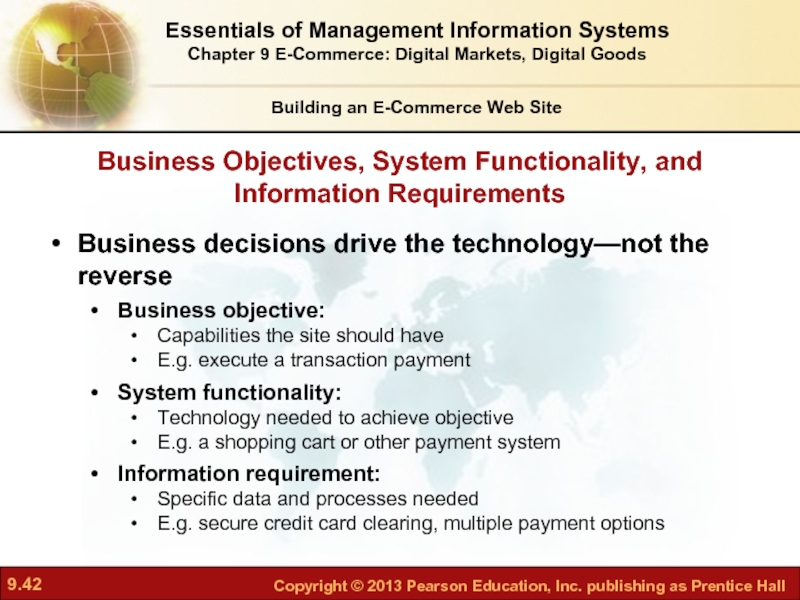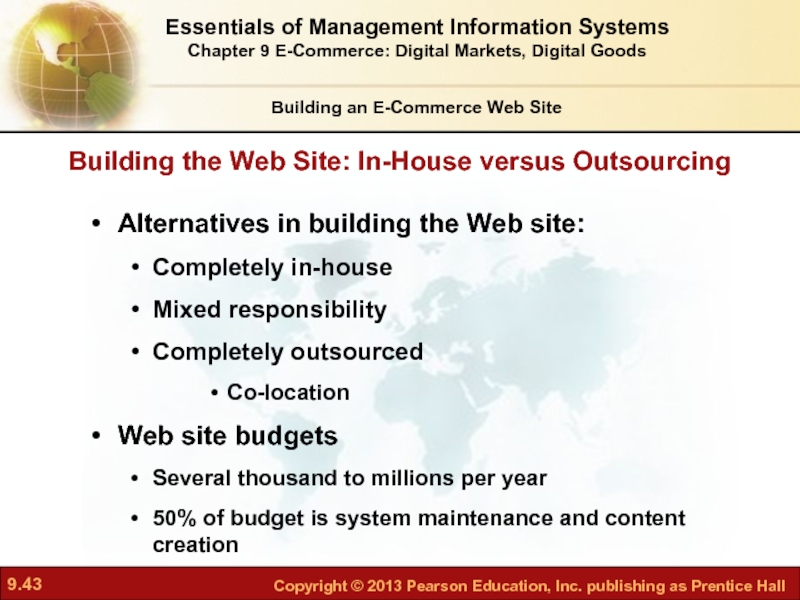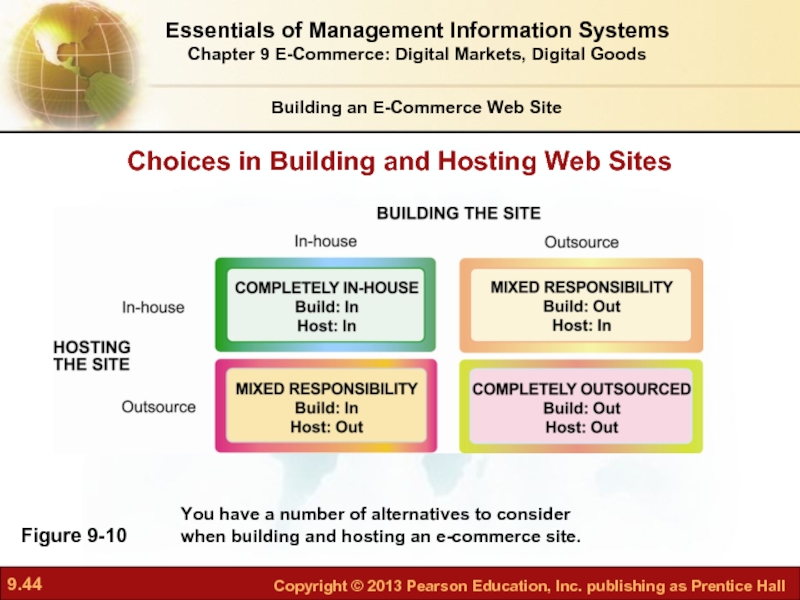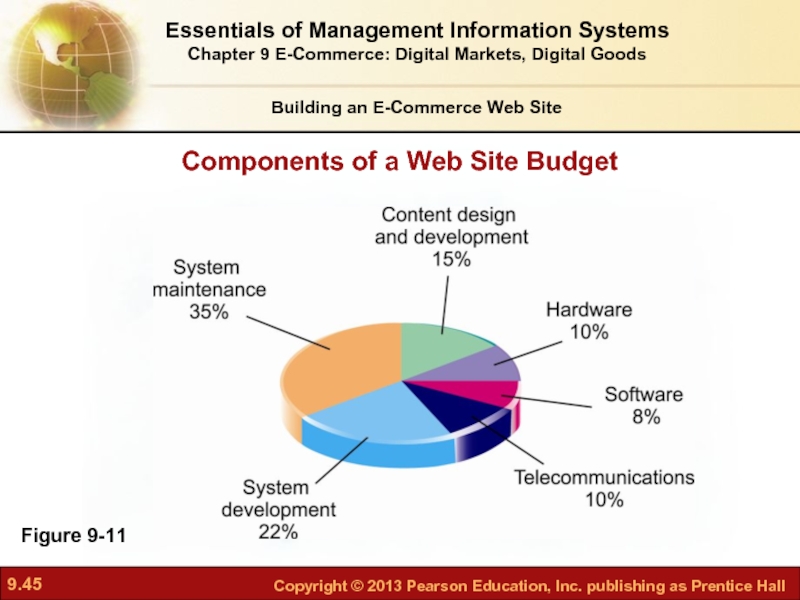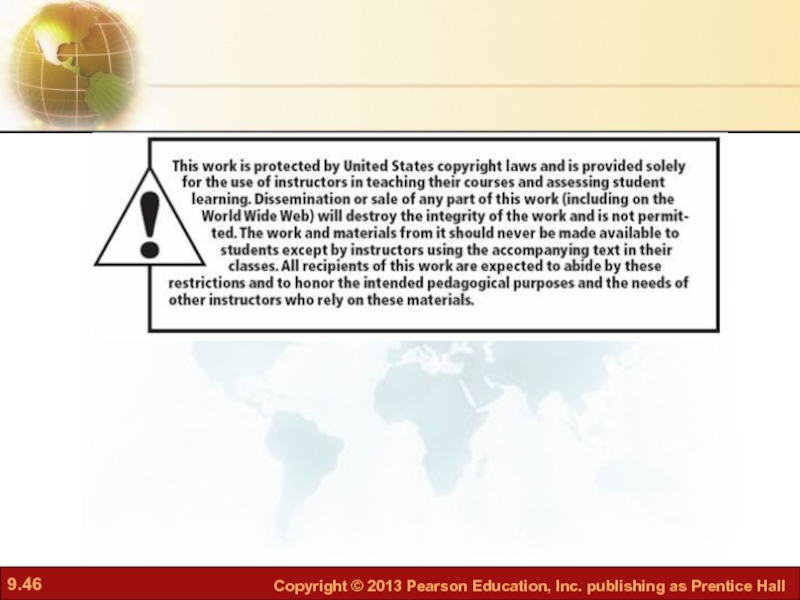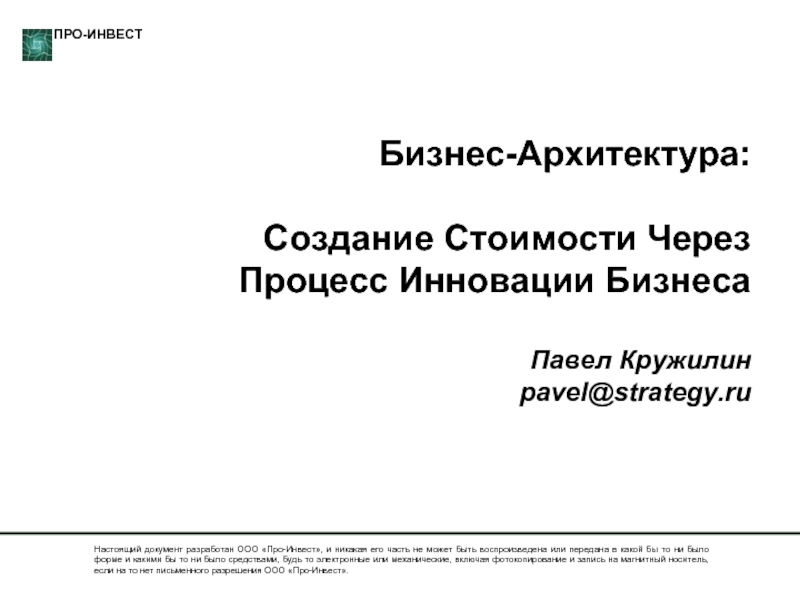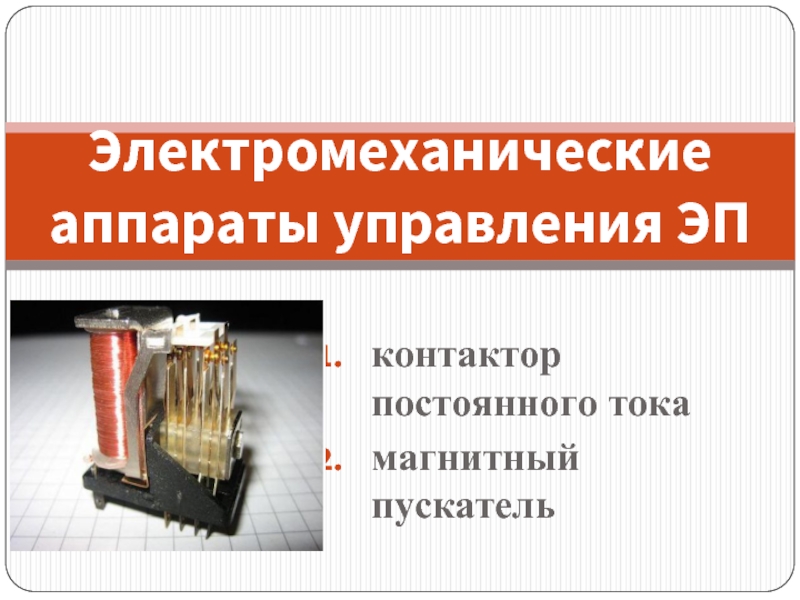- Главная
- Разное
- Дизайн
- Бизнес и предпринимательство
- Аналитика
- Образование
- Развлечения
- Красота и здоровье
- Финансы
- Государство
- Путешествия
- Спорт
- Недвижимость
- Армия
- Графика
- Культурология
- Еда и кулинария
- Лингвистика
- Английский язык
- Астрономия
- Алгебра
- Биология
- География
- Детские презентации
- Информатика
- История
- Литература
- Маркетинг
- Математика
- Медицина
- Менеджмент
- Музыка
- МХК
- Немецкий язык
- ОБЖ
- Обществознание
- Окружающий мир
- Педагогика
- Русский язык
- Технология
- Физика
- Философия
- Химия
- Шаблоны, картинки для презентаций
- Экология
- Экономика
- Юриспруденция
Chapter 9. E-commerce: digital markets, digital goods презентация
Содержание
- 1. Chapter 9. E-commerce: digital markets, digital goods
- 2. STUDENT LEARNING OBJECTIVES Essentials of Management Information
- 3. STUDENT LEARNING OBJECTIVES How has e-commerce affected
- 4. Groupon’s Business Model: Social and Local Problem:
- 5. Groupon offers subscribers daily deals from local
- 6. Essentials of Management Information Systems Chapter 9
- 7. E-Commerce and the Internet E-Commerce Today
- 8. E-Commerce and the Internet Figure 9-1 The
- 9. Why E-Commerce Is Different E-Commerce and the
- 10. Unique Features of E-Commerce Technology E-Commerce and
- 11. Unique Features of E-Commerce Technology E-Commerce and
- 12. Unique Features of E-Commerce Technology E-Commerce and
- 13. Unique Features of E-Commerce Technology E-Commerce and
- 14. Unique Features of E-Commerce Technology E-Commerce and
- 15. Unique Features of E-Commerce Technology E-Commerce and
- 16. Unique Features of E-Commerce Technology E-Commerce and
- 17. Key Concepts: Digital Markets and Digital Goods
- 18. E-Commerce and the Internet Figure 9-2 The
- 19. E-Commerce and the Internet Digital goods Goods
- 20. Types of E-Commerce E-Commerce: Business and Technology
- 21. E-Commerce Business Models E-Commerce: Business and Technology
- 22. Interactive Session: Organizations Walmart, Amazon, and eBay:
- 23. E-Commerce Revenue Models E-Commerce: Business and Technology
- 24. Web 2.0, Social Networking and the Wisdom
- 25. E-Commerce Marketing Internet provides marketers with new
- 26. E-Commerce: Business and Technology Figure 9-3 E-Commerce
- 27. E-Commerce: Business and Technology Figure 9-4 Firms
- 28. E-Commerce: Business and Technology Figure 9-5 How
- 29. Social E-Commerce and Social Network Marketing Social
- 30. Social E-Commerce and Social Network Marketing Social
- 31. Interactive Session: People Social Commerce Creates New
- 32. B2B E-Commerce: New Efficiencies and Relationships E-Commerce:
- 33. E-Commerce: Business and Technology Figure 9-6 Companies
- 34. B2B E-Commerce: New Efficiencies and Relationships Private
- 35. E-Commerce: Business and Technology Figure 9-7 A
- 36. Net marketplaces (e-hubs) Single market for many
- 37. E-Commerce: Business and Technology Figure 9-8 Net
- 38. Exchanges Independently owned third-party Net marketplaces Connect
- 39. M-Commerce Services and Applications The Mobile Digital
- 40. The Mobile Digital Platform and Mobile E-Commerce
- 41. Pieces of the Site-Building Puzzle Building an
- 42. Business Objectives, System Functionality, and Information Requirements
- 43. Building the Web Site: In-House versus Outsourcing
- 44. Figure 9-10 Choices in Building and Hosting
- 45. Figure 9-11 Components of a Web Site
Слайд 19
Chapter
E-Commerce: Digital Markets, Digital Goods
Video cases:
Case 1 M-Commerce: The
Case 2 Ford AutoXchange B2B Marketplace
Слайд 2STUDENT LEARNING OBJECTIVES
Essentials of Management Information Systems
Chapter 9 E-Commerce: Digital Markets,
What are the unique features of e-commerce, digital markets, and digital goods?
What are the principal e-commerce business and revenue models?
How has e-commerce transformed marketing?
Слайд 3STUDENT LEARNING OBJECTIVES
How has e-commerce affected business-to-business transactions?
What is the role
What issues must be addressed when building an e-commerce presence?
Essentials of Management Information Systems
Chapter 9 E-Commerce: Digital Markets, Digital Goods
Слайд 4Groupon’s Business Model: Social and Local
Problem: Competing with other business models
Solution? Scale: Get big quick to build a brand to prevent competitors from finding audience
Essentials of Management Information Systems
Chapter 9 E-Commerce: Digital Markets, Digital Goods
Слайд 5Groupon offers subscribers daily deals from local merchants
The catch: A group
Coupon is typically 50% off; Groupon receives 50% of remaining revenue
Demonstrates use of social networking technologies in generating new business models
Illustrates the difficulties many social networking sites have in showing a profit or monetizing
Essentials of Management Information Systems
Chapter 9 E-Commerce: Digital Markets, Digital Goods
Groupon’s Business Model: Social and Local
Слайд 6Essentials of Management Information Systems
Chapter 9 E-Commerce: Digital Markets, Digital Goods
Groupon’s
Слайд 7E-Commerce and the Internet
E-Commerce Today
E-commerce: use of the Internet and Web
Began in 1995 and grew exponentially; still stable even in a recession
Companies that survived the dot-com bubble burst and now thrive
E-commerce revolution is still in its early stages
Essentials of Management Information Systems
Chapter 9 E-Commerce: Digital Markets, Digital Goods
Слайд 8E-Commerce and the Internet
Figure 9-1
The Growth of E-Commerce
Essentials of Management Information
Chapter 9 E-Commerce: Digital Markets, Digital Goods
Retail e-commerce revenues grew 15–25 % per year until the recession of 2008–2009, when they slowed measurably. In 2011, e-commerce revenues are growing again at an estimated 14% annually.
Слайд 9Why E-Commerce Is Different
E-Commerce and the Internet
Ubiquity
Internet/Web technology available everywhere:
Effect:
Marketplace removed from temporal, geographic locations to become “marketspace”
Enhanced customer convenience and reduced shopping costs
Essentials of Management Information Systems
Chapter 9 E-Commerce: Digital Markets, Digital Goods
Слайд 10Unique Features of E-Commerce Technology
E-Commerce and the Internet
Global reach
The technology reaches
Effect:
Commerce enabled across cultural and national boundaries seamlessly and without modification.
Marketspace includes, potentially, billions of consumers and millions of businesses worldwide
Essentials of Management Information Systems
Chapter 9 E-Commerce: Digital Markets, Digital Goods
Слайд 11Unique Features of E-Commerce Technology
E-Commerce and the Internet
Universal standards
One set of
Effect:
Disparate computer systems easily communicate with one another
Lower market entry costs—costs merchants must pay to bring goods to market
Lower consumers’ search costs—effort required to find suitable products
Essentials of Management Information Systems
Chapter 9 E-Commerce: Digital Markets, Digital Goods
Слайд 12Unique Features of E-Commerce Technology
E-Commerce and the Internet
Richness
Supports video, audio, and
Effect:
Possible to deliver rich messages with text, audio, and video simultaneously to large numbers of people
Video, audio, and text marketing messages can be integrated into single marketing message and consumer experience
Essentials of Management Information Systems
Chapter 9 E-Commerce: Digital Markets, Digital Goods
Слайд 13Unique Features of E-Commerce Technology
E-Commerce and the Internet
Interactivity
The technology works through
Effect:
Consumers engaged in dialog that dynamically adjusts experience to the individual
Consumer becomes co-participant in process of delivering goods to market
Essentials of Management Information Systems
Chapter 9 E-Commerce: Digital Markets, Digital Goods
Слайд 14Unique Features of E-Commerce Technology
E-Commerce and the Internet
Information density
Large increases in
Effect:
Greater price transparency
Greater cost transparency
Enables merchants to engage in price discrimination
Essentials of Management Information Systems
Chapter 9 E-Commerce: Digital Markets, Digital Goods
Слайд 15Unique Features of E-Commerce Technology
E-Commerce and the Internet
Personalization/Customization
Technology permits modification of
Effect:
Personalized messages can be sent to individuals as well as groups
Products and services can be customized to individual preferences
Essentials of Management Information Systems
Chapter 9 E-Commerce: Digital Markets, Digital Goods
Слайд 16Unique Features of E-Commerce Technology
E-Commerce and the Internet
Social technology
The technology promotes
Effect:
New Internet social and business models enable user content creation and distribution, and support social networks
Many-to-many model
Essentials of Management Information Systems
Chapter 9 E-Commerce: Digital Markets, Digital Goods
Слайд 17Key Concepts: Digital Markets and Digital Goods
E-Commerce and the Internet
Digital market
Decreased information asymmetry
Reduced search costs and transaction costs
Delayed gratification: effects dependent on product
Reduced menu costs
Increased dynamic pricing
Increased price discrimination
Increased market segmentation
Switching costs: effects dependent on product
Stronger network effects
More disintermediation
Essentials of Management Information Systems
Chapter 9 E-Commerce: Digital Markets, Digital Goods
Слайд 18E-Commerce and the Internet
Figure 9-2
The typical distribution channel has several intermediary
The Benefits of Disintermediation to the Consumer
Essentials of Management Information Systems
Chapter 9 E-Commerce: Digital Markets, Digital Goods
Слайд 19E-Commerce and the Internet
Digital goods
Goods that can be delivered over a
E.g., music tracks, video, software, newspapers, books
Cost of producing first unit almost entire cost of product: marginal cost of producing second unit is about zero
Costs of delivery over the Internet very low
Marketing costs remain the same; pricing highly variable
Industries with digital goods are undergoing revolutionary changes (publishers, record labels, etc.)
Essentials of Management Information Systems
Chapter 9 E-Commerce: Digital Markets, Digital Goods
Слайд 20Types of E-Commerce
E-Commerce: Business and Technology
Business-to-consumer (B2C)
BarnesandNoble.com
Business-to-business (B2B)
ChemConnect
Consumer-to-consumer (C2C)
eBay
Essentials of Management
Chapter 9 E-Commerce: Digital Markets, Digital Goods
Слайд 21E-Commerce Business Models
E-Commerce: Business and Technology
E-tailer
Content provider
Transaction broker
Market creator
Service provider
Community provider
Portal
Essentials
Chapter 9 E-Commerce: Digital Markets, Digital Goods
Слайд 22Interactive Session: Organizations
Walmart, Amazon, and eBay: Who Will Dominate Internet Retailing?
Read
Analyze each of these companies using the value chain and competitive forces models.
Compare the three companies’ e-commerce business models. Which is the strongest? Explain your answer.
Which company is likely to have the strongest retail e-commerce growth in the future? Why?
E-Commerce: Business and Technology
Essentials of Management Information Systems
Chapter 9 E-Commerce: Digital Markets, Digital Goods
Слайд 23E-Commerce Revenue Models
E-Commerce: Business and Technology
Advertising
Sales
Subscription
Free/Freemium
Transaction fee
Affiliate
Essentials of
Chapter 9 E-Commerce: Digital Markets, Digital Goods
Слайд 24Web 2.0, Social Networking and the Wisdom of Crowds
E-Commerce: Business and
Most popular Web 2.0 service: social networking
Social shopping sites: swap shopping ideas with friends (Kaboodle, ThisNext)
Wisdom of crowds
Crowdsourcing
Large numbers of people can make better decisions about topics and products than a single person
Prediction markets
Peer-to-peer betting markets on specific outcomes (elections, sales figures, designs for new products)
Essentials of Management Information Systems
Chapter 9 E-Commerce: Digital Markets, Digital Goods
Слайд 25E-Commerce Marketing
Internet provides marketers with new ways of identifying and communicating
Long tail marketing: ability to reach a large audience inexpensively
Behavioral targeting: tracking online behavior of individuals on thousands of Web sites
Internet advertising formats include search engine marketing, display ads, rich media, and e-mail
E-Commerce: Business and Technology
Essentials of Management Information Systems
Chapter 9 E-Commerce: Digital Markets, Digital Goods
Слайд 26E-Commerce: Business and Technology
Figure 9-3
E-Commerce Web sites have tools to track
Web Site Visitor Tracking
Essentials of Management Information Systems
Chapter 9 E-Commerce: Digital Markets, Digital Goods
Слайд 27E-Commerce: Business and Technology
Figure 9-4
Firms can create unique, personalized Web pages
Web Site Personalization
Essentials of Management Information Systems
Chapter 9 E-Commerce: Digital Markets, Digital Goods
Слайд 28E-Commerce: Business and Technology
Figure 9-5
How an Advertising Network Works
Essentials of Management
Chapter 9 E-Commerce: Digital Markets, Digital Goods
Advertising networks and their use of tracking programs have become controversial among privacy advocates because of their ability to track individual consumers across the Internet.
Слайд 29Social E-Commerce and Social Network Marketing
Social e-commerce:
Based on digital social graph
Mapping
Four features of social e-commerce driving its growth
Social sign-on
Collaborative shopping
Network notification
Social search (recommendations)
E-Commerce: Business and Technology
Essentials of Management Information Systems
Chapter 9 E-Commerce: Digital Markets, Digital Goods
Слайд 30Social E-Commerce and Social Network Marketing
Social media: Fastest growing media for
Social Network Marketing:
Seeks to leverage individuals influence over others in social graph
Target is a social network of people sharing interests and advice
Facebook’s “Like” button
Social networks have huge audiences
Facebook: 162 million U.S. monthly visitors
E-Commerce: Business and Technology
Essentials of Management Information Systems
Chapter 9 E-Commerce: Digital Markets, Digital Goods
Слайд 31Interactive Session: People
Social Commerce Creates New Customer Relationships
Read the Interactive Session
Assess the people, organization, and technology issues for using social media to engage with customers.
What are the advantages and disadvantages of using social media for advertising, brand building, market research, and customer service?
Should all companies use Facebook and Twitter for customer service and advertising? Why or why not? What kinds of companies are best suited to use these platforms?
E-Commerce and the Internet
Essentials of Management Information Systems
Chapter 9 E-Commerce: Digital Markets, Digital Goods
Слайд 32B2B E-Commerce: New Efficiencies and Relationships
E-Commerce: Business and Technology
Essentials of Management
Chapter 9 E-Commerce: Digital Markets, Digital Goods
Electronic data interchange (EDI)
Computer-to-computer exchange of standard transactions such as invoices, purchase orders
Major industries have EDI standards that define structure and information fields of electronic documents for that industry
More companies increasingly moving away from private networks to Internet for linking to other firms
E.g. procurement: businesses can now use the Internet to locate most low-cost supplier, search online catalogs of supplier products, negotiate with suppliers, place orders, etc.
Слайд 33E-Commerce: Business and Technology
Figure 9-6
Companies use EDI to automate transactions for
Electronic Data Interchange
Essentials of Management Information Systems
Chapter 9 E-Commerce: Digital Markets, Digital Goods
Слайд 34B2B E-Commerce: New Efficiencies and Relationships
Private industrial network (private exchange)
Large firm
Owned by buyer
Permits sharing of:
Product design and development
Marketing
Production scheduling and inventory management
Unstructured communication (graphics and e-mail)
E-Commerce: Business and Technology
Essentials of Management Information Systems
Chapter 9 E-Commerce: Digital Markets, Digital Goods
Слайд 35E-Commerce: Business and Technology
Figure 9-7
A private industrial network, also known as
A Private Industrial Network
Essentials of Management Information Systems
Chapter 9 E-Commerce: Digital Markets, Digital Goods
Слайд 36Net marketplaces (e-hubs)
Single market for many buyers and sellers
Industry-owned or owned
Generate revenue from transaction fees, other services
Use prices established through negotiation, auction, RFQs, or fixed prices
May focus on direct or indirect goods
May be vertical or horizontal marketplaces
E-Commerce: Business and Technology
Essentials of Management Information Systems
Chapter 9 E-Commerce: Digital Markets, Digital Goods
Слайд 37E-Commerce: Business and Technology
Figure 9-8
Net marketplaces are online marketplaces where multiple
A Net Marketplace
Essentials of Management Information Systems
Chapter 9 E-Commerce: Digital Markets, Digital Goods
Слайд 38Exchanges
Independently owned third-party Net marketplaces
Connect thousands of suppliers and buyers for
Typically provide vertical markets for direct goods for single industry (food, electronics)
Proliferated during early years of e-commerce; many have failed
Competitive bidding drove prices down and did not offer long-term relationships with buyers or services to make lowering prices worthwhile
E-Commerce: Business and Technology
Essentials of Management Information Systems
Chapter 9 E-Commerce: Digital Markets, Digital Goods
Слайд 39M-Commerce Services and Applications
The Mobile Digital Platform and Mobile E-Commerce
Although m-commerce
Location-based services
Banking and financial services
Mobile advertising and retailing
Games and entertainment
Essentials of Management Information Systems
Chapter 9 E-Commerce: Digital Markets, Digital Goods
Слайд 40The Mobile Digital Platform and Mobile E-Commerce
Figure 9-9
Consolidated Mobile Commerce Revenues
Essentials
Chapter 9 E-Commerce: Digital Markets, Digital Goods
Mobile
e-commerce is the fastest growing type of B2C
e-commerce although it represents only a small part of all e-commerce in 2011.
Слайд 41Pieces of the Site-Building Puzzle
Building an E-Commerce Web Site
Assembling a team
Technology
Site design
Social and information policies
Hardware, software, and telecommunications infrastructure
Customer’s demands should drive the site’s technology and design
Essentials of Management Information Systems
Chapter 9 E-Commerce: Digital Markets, Digital Goods
Слайд 42Business Objectives, System Functionality, and Information Requirements
Building an E-Commerce Web Site
Business
Business objective:
Capabilities the site should have
E.g. execute a transaction payment
System functionality:
Technology needed to achieve objective
E.g. a shopping cart or other payment system
Information requirement:
Specific data and processes needed
E.g. secure credit card clearing, multiple payment options
Essentials of Management Information Systems
Chapter 9 E-Commerce: Digital Markets, Digital Goods
Слайд 43Building the Web Site: In-House versus Outsourcing
Building an E-Commerce Web Site
Alternatives
Completely in-house
Mixed responsibility
Completely outsourced
Co-location
Web site budgets
Several thousand to millions per year
50% of budget is system maintenance and content creation
Essentials of Management Information Systems
Chapter 9 E-Commerce: Digital Markets, Digital Goods
Слайд 44Figure 9-10
Choices in Building and Hosting Web Sites
Essentials of Management Information
Chapter 9 E-Commerce: Digital Markets, Digital Goods
You have a number of alternatives to consider when building and hosting an e-commerce site.
Building an E-Commerce Web Site
Слайд 45Figure 9-11
Components of a Web Site Budget
Essentials of Management Information Systems
Chapter
Building an E-Commerce Web Site
